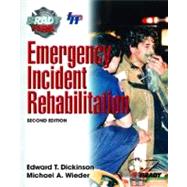
Edward T. Dickinson, MD, NREMT P, FACEP, is currently Assistant Professor and Director of EMS Field Operations in the Department of Emergency Medicine of the University of Pennsylvania School of Medicine in Philadelphia. He is currently Medical Director of the Malvern Fire Company, the Berwyn Fire Company, and the Township of Haverford paramedics in Pennsylvania. He is a residency-trained, board-certified emergency medicine physician who is a Fellow of the American College of Emergency Physicians.
He began his career in emergency services in 1979 as a firefighter-EMT in upstate New York. As a volunteer firefighter, he served as a company officer, assistant chief, and training officer. In 1985, he was the first volunteer firefighter in the United States to receive the top award for heroism from the Firehouse Magazine Heroism and Community Awards program in recognition of his rescue of two elderly women trapped in a house fire.
Dr. Dickinson has remained active in fire service and EMS for the past 25 years. He frequently rides with EMS units and has maintained his certification as a National Registry EMT-Paramedic. He has served as medical editor for numerous Brady EMT -B and First Responder texts and is the author of Fire Service Emergency Care, and co-author of Emergency Care-Fire Services Edition, EMT-B textbooks.
Michael A. Wieder, MS, CFPS, MIFireE, is the Assistant Director at Fire Protection Publications, headquarters for the International Fire Service Training Association (IFSTA), at Oklahoma State University in Stillwater, Oklahoma. He has written or edited over two dozen books and 100 periodical articles. Mr. Wieder holds an Associate Degree in Fire Technology from Northampton Community College in Bethlehem, Pennsylvania. He also holds a Bachelor's Degree in Fire Protection and Safety Engineering Technology and a Master's Degree in Occupational and Adult Education from Oklahoma State University. A Certified Fire Protection Specialist and a member of the Institution of Fire Engineers, he is a member of the National Fire Protection Association's Fire Fighter Professional Qualifications (NFPA 1001) and Fire Service Training committees, serves as secretary of the National Fire Service Incident Management System Consortium, and is IFSTA's representative to the National Volunteer Fire Council (NVFC). He is a contributing editor to Firehouse ® Magazine and The Pennsylvania Fireman. He maintains a very active fire service lecture and legal consultation workload.
Mr. Wieder began his fire service career in 1979 as a volunteer firefighter with the Pennsburg, Pennsylvania, Fire Company. He also served as a volunteer and part-paid firefighter with the Stillwater, Oklahoma, Fire Department.
| Preface | p. ix |
| Acknowledgments | p. xiii |
| About the Authors | p. xv |
| What Is Rehab and Why Do We Need It? | p. 1 |
| Background to Rehab | p. 2 |
| What Is Rehab? | p. 4 |
| Why Do We Need Rehab? | p. 5 |
| The Functions of a Rehab Operation | p. 11 |
| Knowing When to Establish Rehab | p. 15 |
| When to Establish Rehab | p. 16 |
| Rehab Within the Incident Management System | p. 38 |
| Rehab's Role in the Personnel Accountability System | p. 49 |
| Establishing and Managing a Rehab Area | p. 53 |
| Choosing a Rehab Area | p. 54 |
| Rehab Apparatuses and Equipment | p. 59 |
| Operating a Rehab Area | p. 77 |
| Medical Aspects of Rehab Operations | p. 89 |
| Principles Guiding Rehab Operations | p. 90 |
| Injuries and Illnesses at Emergency Incident Scenes | p. 92 |
| Medical Staffing of the Rehab Sector | p. 104 |
| Medical Equipment in the Rehab Sector | p. 105 |
| Entry and Triage | p. 107 |
| Medical Evaluation/Treatment Unit | p. 109 |
| Fluids and Nutrition in Rehab | p. 114 |
| Basic Concepts | p. 115 |
| Fluids and Electrolytes | p. 116 |
| Provision of Solid Foods in Rehab | p. 123 |
| Conclusion | p. 127 |
| Index | p. 129 |
| Table of Contents provided by Ingram. All Rights Reserved. |
The New copy of this book will include any supplemental materials advertised. Please check the title of the book to determine if it should include any access cards, study guides, lab manuals, CDs, etc.
The Used, Rental and eBook copies of this book are not guaranteed to include any supplemental materials. Typically, only the book itself is included. This is true even if the title states it includes any access cards, study guides, lab manuals, CDs, etc.